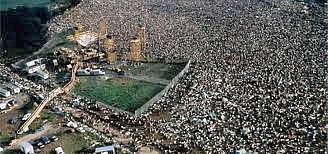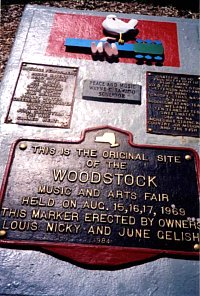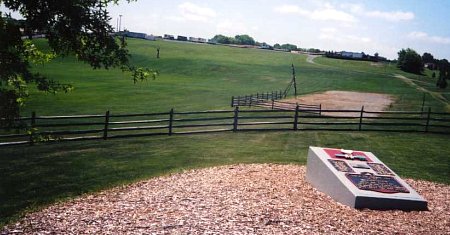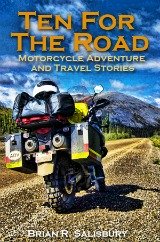Sign up today to get your FREE newsletter and BONUS info!
Add the Woodstock Festival Site to Your List of
"Must" Motorcycle Rides in New York

Any list of great motorcycle rides in New York should include a visit to the fabled Woodstock Festival site in the town of Bethel.
Many years after I experienced this phenomenal happening, I was drawn back to the green alfalfa field where it had all taken place.
Here's what I found…
"Woodstock"...
It was the summer of 1969 -- August 16, to be exact -- when three friends and I walked into a vast alfalfa field where we joined more than 450,000 others to experience firsthand the phenomenon now known simply by this one iconic name.
The event became the icon of an era and of a generation. But, at the time, it was simply a disorganized happening wrapped in music and, for many, marinated with drugs.
Furthermore...I had no clear idea why I was there.
The night before we arrived at the festival site, my friend Ken and I, along with Ken’s girlfriend and her roommate from college, spent a sweltering eight hours under an abandoned chicken coop in the wilds of upstate New York.
While the coop sheltered us from the pouring rain, the essence of chicken permeated everything around us, and the mosquitoes buzzing next to our ears made sleep almost impossible.
Many times that night I thought: “What the heck are we doing here?"
I still don’t have a good answer. But, looking back through the prism of time, I’m glad we endured the discomfort.
The rain finally stopped and the morning sun climbed over the trees. Leaving our fragrant lodgings behind, we walked about five miles to a vast, muddy alfalfa field.
And there we joined nearly half a million other wanderers to experience firsthand the phenomenon now known simply as "Woodstock."
How it all started for us
Months earlier, Ken convinced me to pitch in with him and the two ladies to attend part of the four-day-long Woodstock Music and Art Fair in the small town of Bethel, New York -- population 2,366. None of us was even slightly into the hippie scene. Somehow we assumed this would be an artsy gathering.
Big mistake.
A bit of trivia: The event’s promoters wanted to draw on the singer Bob Dylan’s aura by naming the August 15-18 concert after Dylan’s hip little hometown of Woodstock, New York, located 70 miles northeast of Bethel.
The music began Friday afternoon at 5:07 p.m. August 15 and continued until mid-morning on Monday, August 18.
Over the years, the town of Woodstock has capitalized more on the promoters’ original marketing ploy and the nostalgia surrounding the Woodstock Generation than has Bethel -- were the epic happening actually took place in 1969.
Getting there was half the fun
When the Woodstock weekend finally arrived, so did the rain -- lots of it. While Ken and I raced around town to gather last minute supplies for our two-day outing, the heavy rain flooded the interior of his leaky Volkswagen beetle.
Back at Ken’s house in Paramus, N.J., we began the slow process of bailing out his car. Ken figured we could speed things along by jacking up the beetle’s rear end so the water would pool in front. This worked, but Ken was impatient.
He disappeared into his house and returned with a .38 revolver. He reached into the car an unceremoniously shot a hole through the driver’s side floor. The water drained rapidly through the bullet hole.
Ken was pleased with his ingenuity.
Throughout that Saturday we’d been hearing reports about massive traffic jams on the New York State Throughway and on other major roads approaching Bethel.
The concert had begun the night before and thousands of people were still streaming in from all directions. State Troopers were trying, unsuccessfully, to turn them away.
At about 2:00 p.m. the beetle was packed and the four of us drove north into New York. We planned on taking back roads to get as close as possible to the concert location. Then we’d walk.
Lots of other people had the same idea. Traffic was a mess and the rain continued. It took us five hours to go about 100 miles.
By about 7 p.m. we’d gotten within striking distance of Bethel and decided to stop for the night.
We negotiated a deal with a friendly farmer to park the car and camp on his property. He offered us the shelter of his deserted chicken coop plus breakfast. Sort of a bed-and-breakfast conjured up by Stephen King.
But we were happy for it.
Very early the following morning, true to his word, we joined the farmer and his family for breakfast.
They were quite amazed at the steady stream of humanity that, for days, had been shambling past their house toward Bethel.
After breakfast, we threw our sleeping bags into the car, took out a cooler of food and joined the flow.
Like lemmings in low gear, we swarmed toward the ocean of music and humanity.
The scene
About two hours later we reached the outer edge of the 38-acre bowl-shaped pasture where the concert was taking place.
This land and the 600 acres surrounding it belonged to Max Yasgur, a Bethel dairy farmer and the largest milk producer in Sullivan County.
Yasgur’s name is forever linked to Woodstock. He essentially rescued the “music and art fair” by striking a deal with the promoters that allowed them to hold the event on his property.
A few weeks earlier, the town of Wallkill, New York, had reneged on its promise to provide a venue. I’m sure Mr. Yasgur was as amazed as we were with the result of his agreement.
People were strewn everywhere and the rain had turned the verdant fields to mud. We stepped between the bodies and worked our way toward a spot where we could at least see the stage.
As we crested the upper rim of this natural amphitheater, the land sloped down toward the huge stage about 300 yards away. Tall, red erector-set towers -- three on each side of the stage -- supported the powerful sound system.
The sun shone bright on acres of vivid colors: naked body colors, tie-dyed shirt colors, green tent colors, yellow ground cloth colors, flower power colors, funny hat colors.
For a few days, the Woodstock Festival location was actually one of the most heavily populated places in the world.
After enduring two days of rain, the people flaked out in the warm sun and listened to the music -- sort of.
Even though the speaker system was quite massive, when the tunes reached the top of the amphitheater, they sounded similar to garbled New York City subway announcements.
Nobody cared.
We found a hunk of empty space large enough to put down a blanket and lounge out. And that’s where we stayed for the next eight hours -- listening to the music, eating, sleeping, sunning, watching the show around us and adding our own vibes to this concentration of mellow energy.
Time to go
Late in the afternoon we gathered up our blanket and gave away the remainder of our food and drinks. The concert was scheduled to continue into Monday afternoon, but for us it was over. We meandered back toward the road and began a slow walk to the car.
The crowds thinned as we got farther away.
Along the way we passed a grove of trees set back from the road. A couple sitting on a blanket among the trees was cutting up a watermelon while listening to the concert on the radio.
The thought drifted through my mind that, perhaps, they had the best seats in the house. I recall that scene today as clearly as I recall the colors filling the amphitheater.
The Woodstock site becomes a Mecca for many visitors -- including the destination for motorcycle rides in New York
Since Woodstock happened in 1969, thousands of pilgrims have been drawn to the pasture where the concert took place.
And it the destination for many motorcycle rides in New York.
Some come to revisit the site where they saw it all happen and some come to see the spot for the first time. However, for years, the location was difficult to find and identify.
During the mid-1980s, a welder named Wayne Seward built a 5 1/2-ton concrete and cast iron monument commemorating Woodstock.

One plaque on the barn-door-sized monolith displays the Woodstock Festival logo -- a dove on the neck of a guitar.
Two other plaques list just about all of the musical groups and individual performers who entertained the throng during the event.
Brooklyn resident Louis Nicky, who bought the 38-acre site from widow Yasgur, worked with Seward to place the marker just off the intersection of West Shore and Hurd Road -- approximately where the huge stage and tall sound-system towers had stood.
Once the marker went into the ground, the site became something of a shrine, with visitors showing up randomly to gaze across the fields and as a destination for motorcycle rides in New York.
They turned it into a performing arts center
In 1996, the Woodstock story took a interesting twist when Sullivan County resident and billionaire Alan Gerry completed the stealthy purchase of the 38-acre concert site along with 1,000-adjacent acres.
In 2000, Gerry and New York State Governor George Pataki announced Gerry's plans to build a $40 million performing arts and music center near, but not directly on, the cherished natural amphitheatre.
Which he did…
My return to Woodstock
Over the years, I hadn’t really thought much about my own Woodstock experience…nor did I have the desire to return to the area.
But nearly 30 years after I'd experienced the event, I got the urge to take one of my motorcycle rides in New York to Sullivan County. I wanted to look for and visit the site.
I took a circuitous route through the beautiful Catskill Mountains to the town of Bethel and drove slowly along Route 17B. Quite unexpectedly, I saw a street sign for Hurd Road and made a turn.
I drove along Hurd Road, trying to spot a street sign for West Shore Road. I also scanned the fields, hoping to recognize the bowl-shaped pasture.
No luck.
At the end of Hurd Road, I turned around and drove back. I’d passed one street that didn’t have a sign at the intersection. Maybe that was it.
As I approached the intersection, this time I spotted a small parking lot near a mowed and landscaped area surrounded by a wooden fence. On the other side of the fence I saw the huge marker. And past the marker, the green pasture rose up and away.

I parked the bike in the empty lot, entered the landscaped area through an opening in the fence and walked over to the marker.
It was a cold, overcast, blustery day -- not the best for one of my motorcycle rides in New York. However, due the dreary weather, I had the whole place to myself.
As I looked out across the field, the warm memory of that strange weekend and the spirit of Woodstock washed over me. I was surprised at how peaceful I felt and how pleasant it was to be here again.
Apparently the whole experience back then had affected me more than I'd realized. And this motorcycle ride in New York brought it all back.
I snapped about a dozen pictures of the monument and the surrounding area then headed back to the motorcycle.
Before I put away my camera, a woman stopped her car in the parking lot and appeared to be describing the area to the small boy with her. I thought, “What the heck, I’ll ask her to take my photo next to the monument.”
I walked over to the car and the woman partially rolled down the window. I explained that it had been more than 30 years since I’d been here for the event, and would she mind taking my picture.
I could see in her eyes that she wasn’t comfortable with the idea, and she was reluctant to get out of the car. I stepped back and thanked her anyway.
I guess my tie-dyed leather jacket and rose-colored, heart-shaped “love” glasses turned her off.
But hey...that’s cool...I can dig it...Peace.
These are the musical groups and individual performers who entertained the thousands of people at Woodstock…
- Joan Baez
- The Band
- Blood, Sweat & Tears
- The Paul Butterfield Blues Band
- Canned Heat
- Joe Cocker
- Country Joe McDonald and The Fish
- Creedence Clearwater Revival
- Crosby, Stills, Nash & Young
- The Grateful Dead
- Arlo Guthrie
- Tim Hardin
- Richie Havens
- Incredible String Band
- The Jeff Beck Group
- Jimi Hendrix
- Jefferson Airplane
- Janis Joplin
- The Keef Hartley Band
- Melanie
- Mountain
- Quill
- Santana
- John Sebastian
- Sha-Na-Na
- Ravi Shankar
- Sly & The Family Stone
- Bert Sommer
- Sweetwater
- Ten Years After
- The Who
- Johnny Winter
Do You Enjoy Motorcycle Stories?
You can find a nice variety of motorcycle travel, adventure and riding stories in my "Ten for the Road" series of books.
Click here to zero-in on three collections of motorcycle stories for your reading pleasure…
Tell Us Your Motorcycle Riding Story
Share with us your motorcycle story -- or stories -- about a terrific ride, great destination or lessons learned...
Let's stay in touch!
Get your free subscription to..."Savvy Motorcyclist E-zine"
And you'll also receive your free copies of...“The 10 Best Motorcycle Travel and Trip Planning Websites on the Internet” ... plus the Motorcycle Safety Foundation’s 58-page Motorcycle Operator’s Manual.
These great resources will help you to ride better, plan your trips, enjoy the best motorcycle roads and get the most out of motorcycle riding.

